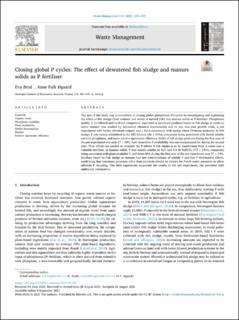| dc.contributor.author | Brod, Eva | |
| dc.contributor.author | Øgaard, Anne Falk | |
| dc.date.accessioned | 2021-10-14T11:43:43Z | |
| dc.date.available | 2021-10-14T11:43:43Z | |
| dc.date.created | 2021-09-10T10:46:40Z | |
| dc.date.issued | 2021-09-09 | |
| dc.identifier.citation | Waste Management. 2021, 135 190-198. | en_US |
| dc.identifier.issn | 0956-053X | |
| dc.identifier.uri | https://hdl.handle.net/11250/2823018 | |
| dc.description.abstract | The aim of this study was to contribute to closing global phosphorus (P) cycles by investigating and explaining the effect of fish sludge (feed residues and faeces of farmed fish) and manure solids as P fertiliser. Phosphorus quality in 14 filtered and/or dried, composted, separated or pyrolysed products based on fish sludge or cattle or swine manure was studied by sequential chemical fractionation and in two two-year growth trials, a pot experiment with barley (Hordeum vulgare) and a field experiment with spring wheat (Triticum aestivum). In fish sludge, P was mainly solubilised in the HCl fraction (66 ± 10%), commonly being associated with slowly soluble calcium phosphates, and mean relative agronomic efficiency (RAE) of fish sludge products during the first year of the pot experiment was only 47 ± 24%. Low immediate P availability was not compensated for during the second year. Thus efforts are needed to optimise the P effects if fish sludge is to be transformed from a waste into a valuable fertiliser. In manure solids, P was mainly soluble in H2O and 0.5 M NaHCO3 (72 ± 14%), commonly being associated with plant-available P, and mean RAE during the first year of the pot experiment was 77 ± 19%. Biochars based on fish sludge or manure had low concentrations of soluble P and low P fertilisation effects, confirming that treatment processes other than pyrolysis should be chosen for P-rich waste resources to allow efficient P recycling. The field experiment supported the results of the pot experiment, but provided little additional information. | en_US |
| dc.language.iso | eng | en_US |
| dc.publisher | Elsevier Ltd. | en_US |
| dc.rights | Navngivelse 4.0 Internasjonal | * |
| dc.rights.uri | http://creativecommons.org/licenses/by/4.0/deed.no | * |
| dc.title | Closing global P cycles: The effect of dewatered fish sludge and manure solids as P fertiliser | en_US |
| dc.type | Peer reviewed | en_US |
| dc.type | Journal article | en_US |
| dc.description.version | publishedVersion | en_US |
| dc.rights.holder | © 2021 The Authors | en_US |
| dc.source.pagenumber | 190-198 | en_US |
| dc.source.volume | 135 | en_US |
| dc.source.journal | Waste Management | en_US |
| dc.identifier.doi | 10.1016/j.wasman.2021.08.041 | |
| dc.identifier.cristin | 1933127 | |
| dc.relation.project | Norges forskningsråd: 194051 | en_US |
| dc.relation.project | Norges forskningsråd: 268338 | en_US |
| cristin.ispublished | true | |
| cristin.fulltext | original | |
| cristin.qualitycode | 1 | |

